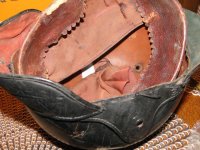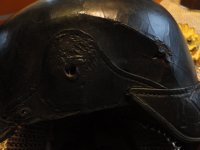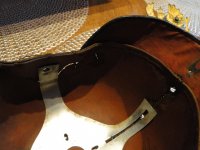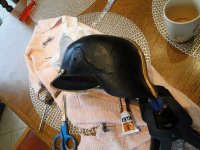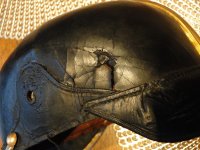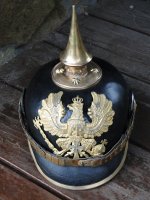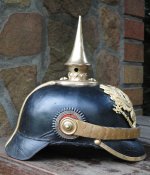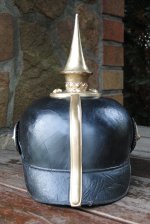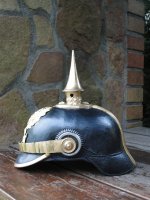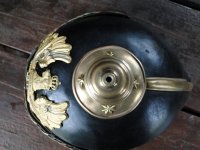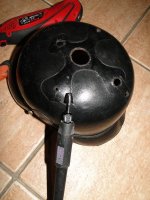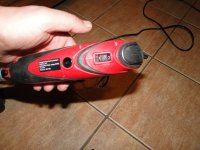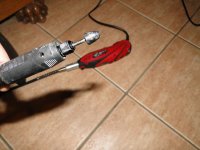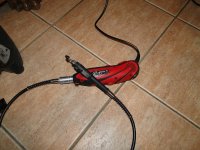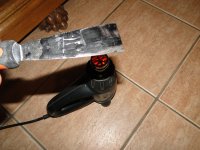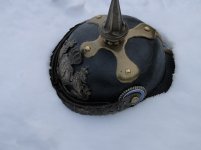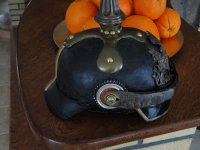You are using an out of date browser. It may not display this or other websites correctly.
You should upgrade or use an alternative browser.
You should upgrade or use an alternative browser.
Small repair pickelhaube
- Thread starter Naprawiacz
- Start date
Naprawiacz
Well-known member
After the repair you can see on the pictures. I filled the polish with this product, which is enough to renovate more than twenty helmets.https://www.ebay.pl/itm/Wachs-fur-Reparaturen-an-Pickelhaube-Raupenhelm-Tschako-Lederscheide-etc/264872907199?hash=item3daba7d1bf:g:lkwAAOSwVL1WA2Sz
Attachments
Hi Wojtek,
Thank you, :thumb up: I looked at the product on eBay and wondered if it was useful, and you have answered my question. Great work on restoring the helmet you have pictured. =D> I really appreciate you taking the time to show me some of your restoration work.
Best regards,
John
Thank you, :thumb up: I looked at the product on eBay and wondered if it was useful, and you have answered my question. Great work on restoring the helmet you have pictured. =D> I really appreciate you taking the time to show me some of your restoration work.
Best regards,
John
Naprawiacz
Well-known member
Hi John.As far as I can see, in the United States and Canada you use a liquid type of shellac, and I repair with German material, which I gave you in the link and which is the closest to the original.Of course, after the repair you can use liquid shellac .I, however, after the repair I use shoe polish designed for the Bundeswehr and I polish.Below I will give you a link to the paste.Now I will show you pictures with the description of how to do it. Divide the cube of the paste into small pieces and heat over the heater so that it forms a liquid mass. Then apply the mass on the damaged coating with a spatula. Then polish with a grinder with rubber or felt pad. It is laborious, but effective. You need to do it in a good light, to do a good job.Regards Wojtek.https://www.ebay.pl/itm/Leder-Pflegemittel-SCHWARZ/254746489318?ssPageName=STRK%3AMEBIDX%3AIT&_trksid=p2057872.m2749.l2649
Attachments
PembrokeYeo
Member
Craftsmanship at its best. Beautiful work.
Naprawiacz
Well-known member
Thank you very much for your kind words! It is worth to live and work for such moments.
My response...I bought this product years ago and I still have this "black bar of wax" but I have never used it. To use it as shown in these pictures, you have to heat it because, it is wax. Yes, initially, it is very easy to fill in a puncture in this helmet as Naprawiacz has shown. Think of lighting up a black candle then dripping the wax into this puncture, crack whatever you choose, the wax fills it. Wax is easy to sand/shape, then you coat it with some black shoe polish, even German Army boot polish...also wax based. As long as this helmet stays in your heated house during the winter, no problem but let us say you are me and I use this product on a customer's helmet and ship it during cool or "really cold" temperatures....it will become brittle, crack and flake off. So let us be clear here...this repair looks easy and slick but it is not a permanent repair. It does look good on a small puncture area however, for large sections of missing finish, are you going to melt this wax and paste it thinly on large sections of shell?
Let me bore you briefly as to what I have tried "finish wise" since the 1980's, trying to replace missing original finish......
First, black shoe polish (wax)....layer after layer trying to build up a "bald spot"., getting it right only to have it crack and flake off. Then having flipped the helmet to a dealer, getting a call...about cracks and flaking.
Ok...shoe polish, "NO GOOD" next....EPOXY CEMENT mixed with black paint powder, yea,....sort of??? Try sanding that shit?? :-? NO good, epoxy just does NOT blend in with the original shellac coating!! Then in my mind, thinking back...there was this old local collector guy who was using liquid shellac from jugs. I guess he dyed it but it was slurped all over the helmets he showed me, like liquid lava, just God awful!!
Then in my mind, thinking back...there was this old local collector guy who was using liquid shellac from jugs. I guess he dyed it but it was slurped all over the helmets he showed me, like liquid lava, just God awful!!
Then I think Tony, I will blame him, talked to me about using shellac flakes dissolved in shellac thinner. So I started with this adding black aniline dye. That worked...layer after layer but then if subjected to cold....my perfect finish, wrinkled with cold temperatures! :-? :-? Unfortunately both Alan and James have been subjected to my failed experimentation and for some reason, they still send me their helmets for restoration.
Then we move on to forum member Sandy, God bless him....he researches and comes up with an original German 1877 haube shellac finish formula!!!!! :thumb up: :thumb up: :thumb up:. Well, we go on from there and that is what I use now, with no problems. I can ship Jeremy's helmet out to the UK a few months back with major finish rework and no problems. Try shipping that wax based product across the Atlantic at 30K Ft in those temperatures. So my friends, back in the day, Hans/Fritz may have been able to melt a bit of black wax into a scrape or dent in his haube finish but this is not a permanent solution today. In all of the hundreds of helmets I have handled by the way, many of which were period repaired....no black wax! In my humble opinion, if you want to go the "black wax" route wait until Halloween and buy some cheap black wax candles.
Let me bore you briefly as to what I have tried "finish wise" since the 1980's, trying to replace missing original finish......
First, black shoe polish (wax)....layer after layer trying to build up a "bald spot"., getting it right only to have it crack and flake off. Then having flipped the helmet to a dealer, getting a call...about cracks and flaking.
Ok...shoe polish, "NO GOOD" next....EPOXY CEMENT mixed with black paint powder, yea,....sort of??? Try sanding that shit?? :-? NO good, epoxy just does NOT blend in with the original shellac coating!!
Then I think Tony, I will blame him, talked to me about using shellac flakes dissolved in shellac thinner. So I started with this adding black aniline dye. That worked...layer after layer but then if subjected to cold....my perfect finish, wrinkled with cold temperatures! :-? :-? Unfortunately both Alan and James have been subjected to my failed experimentation and for some reason, they still send me their helmets for restoration.
Then we move on to forum member Sandy, God bless him....he researches and comes up with an original German 1877 haube shellac finish formula!!!!! :thumb up: :thumb up: :thumb up:. Well, we go on from there and that is what I use now, with no problems. I can ship Jeremy's helmet out to the UK a few months back with major finish rework and no problems. Try shipping that wax based product across the Atlantic at 30K Ft in those temperatures. So my friends, back in the day, Hans/Fritz may have been able to melt a bit of black wax into a scrape or dent in his haube finish but this is not a permanent solution today. In all of the hundreds of helmets I have handled by the way, many of which were period repaired....no black wax! In my humble opinion, if you want to go the "black wax" route wait until Halloween and buy some cheap black wax candles.
Sandmann
Well-known member
Too much of the honor. God may bless you for sharing your restoration experiences :bravo:b.loree said:Then we move on to forum member Sandy, God bless him....he researches and comes up with an original German 1877 haube shellac finish formula!!!!! :thumb up: :thumb up: :thumb up:.
Naprawiacz
Well-known member
Hello everyone.Today I put out a pickelhaube which was completely coated with the said preparation for a few hours at minus 8 degrees Celsius, and after a few hours I took it home where it has been for a few hours at plus 23 degrees Celsius. The effect can be seen in the pictures, nothing has fallen off or cracked, maybe at lower temperatures the cracking process occurs, or maybe it is a matter of humidity and extra pressure on the plane? I do not know the answers to these questions, but thank you for any information.
Attachments
Naprawiacz
Well-known member
I am not questioning the opinion of an outstanding person like Brian, nor his ability, knowledge and experience in restoring objects. I don't do my repairs for profit,just trying to share my experience.I found another recipe for a coating formula.I don't know its proportions yet,but the ingredients include beeswax,brown shellac and Syrian asphalt.What do you think of it? Best regards Wojtek.
No offense taken, by me here in our discussion ...Suum Cuique, everyone has their own methods which they devise to solve problems and restore these helmets!  Wojtek and I share a love of these old pieces and frankly "most normal people" would find us weird :-? for wasting so much time on old leather hats. So regarding your new recipe Wojtek, I have a reprint of an old North American tradesman's "fix it" book which lists a formula for "Japanned Leather" coating. This does include the ingredient of "ashphaltum". However....where can we find that ??? :-? I will post this here on our forum.
Wojtek and I share a love of these old pieces and frankly "most normal people" would find us weird :-? for wasting so much time on old leather hats. So regarding your new recipe Wojtek, I have a reprint of an old North American tradesman's "fix it" book which lists a formula for "Japanned Leather" coating. This does include the ingredient of "ashphaltum". However....where can we find that ??? :-? I will post this here on our forum.
I would remind everyone, that this helmet finish did look good but it also "water proofed" our helmets. Japanning/flexible shellac finish was also applied to horse tack and shoes. I would also suggest.....our helmet cases?? To our members.... reading this discussion, the 1877 formula is a very "natural" thing. Some tree gum from Greece, turpentine, an ingredient from Germany, a can of horse hoof nail polish bought at my local tack store?? :?
I also associate asphalt with tar, as in "tar bucket shako" from Napoleon's armies and again a waterproofing for leather hats. To show my age...tar was poured into the sections of cement sidewalks during my childhood, now they use plastic expansion joint strips. As children on a hot summer's day we would pick out some tar off the side walk and chew it for gum! Despite chewing on a petroleum product on several occasions, I am still alive. So let us continue the discussion gentlemen and lady!
I am still alive. So let us continue the discussion gentlemen and lady!
I would remind everyone, that this helmet finish did look good but it also "water proofed" our helmets. Japanning/flexible shellac finish was also applied to horse tack and shoes. I would also suggest.....our helmet cases?? To our members.... reading this discussion, the 1877 formula is a very "natural" thing. Some tree gum from Greece, turpentine, an ingredient from Germany, a can of horse hoof nail polish bought at my local tack store?? :?
I also associate asphalt with tar, as in "tar bucket shako" from Napoleon's armies and again a waterproofing for leather hats. To show my age...tar was poured into the sections of cement sidewalks during my childhood, now they use plastic expansion joint strips. As children on a hot summer's day we would pick out some tar off the side walk and chew it for gum! Despite chewing on a petroleum product on several occasions,
I failed to mention our member Sergei in my post, both of these gentlemen take helmets which have been in the ground for 100 years + and restore them back to the way they were. I have never had that opportunity, hopefully I might be able to figure that out? :? The Russians like all of Europe and the young N America had their leather workers who knew these formulas. So, let us share information...where are the Germans in all of this? These helmets are their creation, there must be collectors in Germany who have the formulas of these pickelhaube coatings..
Sandmann
Well-known member
You know I have been looking for it for a longer time and asked experts like Jan Kube, the „Gesellschaft für Heereskunde“, some museums and also some hat manufacturers, unfortunately without successthere must be collectors in Germany who have the formulas of these pickelhaube coatings..
I also asked Repro-Helmet-Manufactorers but unfortunately got no answer. But I don't think that they use antique formulars for modern Pickelhaubes.
Keep in mind that Germany was almost completely destroyed in WW2, especially the industrial buildings. In addition everything "Prussian" has been blamed as a reason for war and the Holocaust and it was stigmatized as a "haven of evil", also by the Germans themselves. For this reason I unfortunately have no great hope to find old manufacturing informations.
The only hope would be national archives, but since I don't have an university degree as a historian, I have no entry to many of them and I lack the drive to enroll myself into a university :???: :wink:
Naprawiacz
Well-known member
Dear Brian.Asphaltum or Shilajit is a concentrated form of prehistoric plants that have undergone centuries of humification (decomposition and synthesis). As a result of these transformations, new substances with complex structures and diverse properties have been formed. Shilajit occurs in the form of rock formations mainly in the Himalayas, Caucasus, Altai and other mountain regions. In Poland it is imported from Turkey.Below is a link to the topic.In two weeks I have a meeting with a Polish conservator of monuments, who will give me two formulas.One soft on the skin, and the other hard on the paintings.When I test it I will send you the recipe.Maybe we will agree on something together.Regards cordially Wojtek.https://cadenceboya.pl/srodki-postarzajace/5309-patyna-asphaltum-paint-100ml.html
Naprawiacz
Well-known member
Dear Sandmann.German archives were the best in the world and the recipe must be preserved! Maybe it is in the German patent office? Unfortunately I do not have access to it.Regards Wojtek.
Naprawiacz
Well-known member
Hi all.I have made several projects out of leather,the condition of which was tragic.If you dry it badly,it cracks like a wafer.My method is this: after taking it out of the ground,I dry it for about two weeks in a damp cellar at a temperature of about 5-10 degrees Celsius. Then I paint the object with a brush using a solution of lanolin with turpentine or lanolin with extraction gasoline.Lanolin is obtained from the fat of sheep, which is deposited in a thick layer on their wool. It has a heavy consistency (like wax) and comes in shades of yellow and brown. I then repair the item and lubricate it with white cosmetic petroleum jelly.I am sending some photos of things that I have managed to save.
Naprawiacz
Well-known member
A while ago I received a recipe from a fellow conservationist.You should check it.I am sending two language versions.przepis
wosk pszczeli żółty 40g
mastyks sproszkowany 25g
kalafonia sproszkowana 30g
smoła szewska 10g
asfalt syryjski 25g
twardy wszystkie składniki rozdrobnić dokładnie
w pierwszym naczyniu rozpuszcza się pierwsze cztery składniki
w drugim asfalt i po rozpuszczeniu wlewa się z z 1naczynia do drugiego
aby był bardziej męki dodaje się na 5cz od 3-4 cz łój barani lub wołowy
też można zamiast kalafonii dodać szelak
rozpuszcza się w terpentynie
recipe yellow beeswax 40g
powdered mastic 25g
rosin powder 30g
shoemaker's tar 10g
Syrian asphalt 25g
grind all ingredients thoroughly
in the first vessel dissolve the first four ingredients
Dissolve the asphalt in the second vessel and pour it from the first vessel into the second
to make it more difficult add 3-4 parts of sheep or beef tallow for 5 parts
you can also add shellac instead of rosin
It is dissolved in turpentine.
wosk pszczeli żółty 40g
mastyks sproszkowany 25g
kalafonia sproszkowana 30g
smoła szewska 10g
asfalt syryjski 25g
twardy wszystkie składniki rozdrobnić dokładnie
w pierwszym naczyniu rozpuszcza się pierwsze cztery składniki
w drugim asfalt i po rozpuszczeniu wlewa się z z 1naczynia do drugiego
aby był bardziej męki dodaje się na 5cz od 3-4 cz łój barani lub wołowy
też można zamiast kalafonii dodać szelak
rozpuszcza się w terpentynie
recipe yellow beeswax 40g
powdered mastic 25g
rosin powder 30g
shoemaker's tar 10g
Syrian asphalt 25g
grind all ingredients thoroughly
in the first vessel dissolve the first four ingredients
Dissolve the asphalt in the second vessel and pour it from the first vessel into the second
to make it more difficult add 3-4 parts of sheep or beef tallow for 5 parts
you can also add shellac instead of rosin
It is dissolved in turpentine.
Naprawiacz
Well-known member
Thank you Steve for the link.It looks like you can buy all the products without any problem.The recipe I have presented comes from a gentleman who was a restorer in Poland after the war.His father was a native German and entrusted him with the recipe.Now I have to assemble all the products and make a paste for restoration.Maybe together we can finally crack the enigma code? In Oflag II D Gross-Born, where Polish, French and Russian POWs were held, I found a toothbrush, but the question is whether it was of English or American manufacture? Probably there were still pilots held there, English or American? Maybe someone knows the answer?

